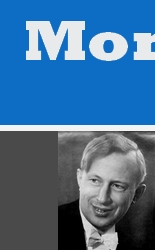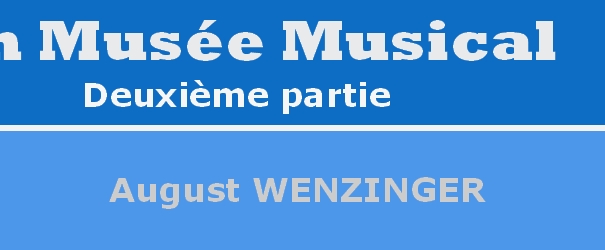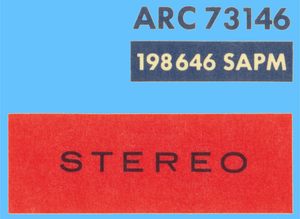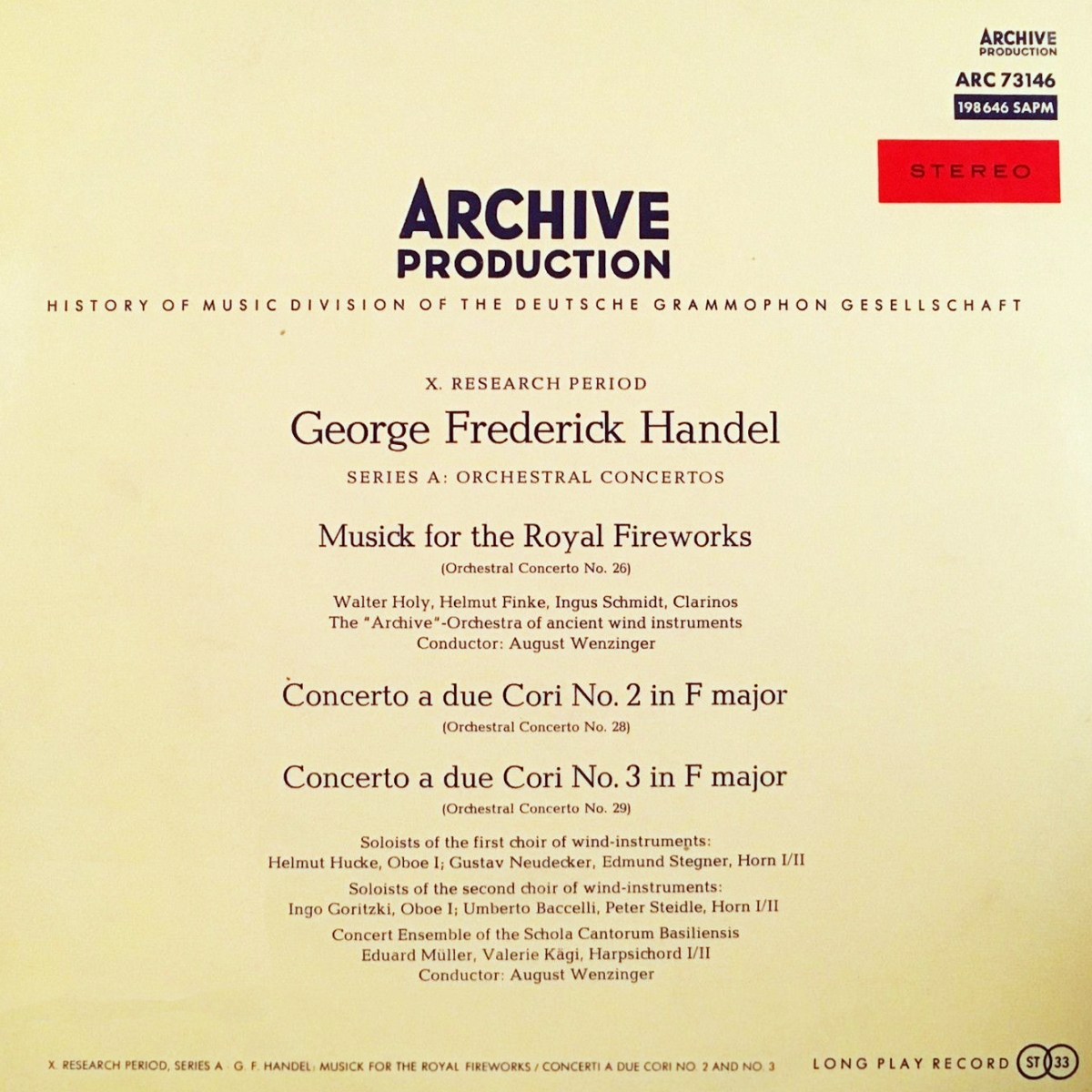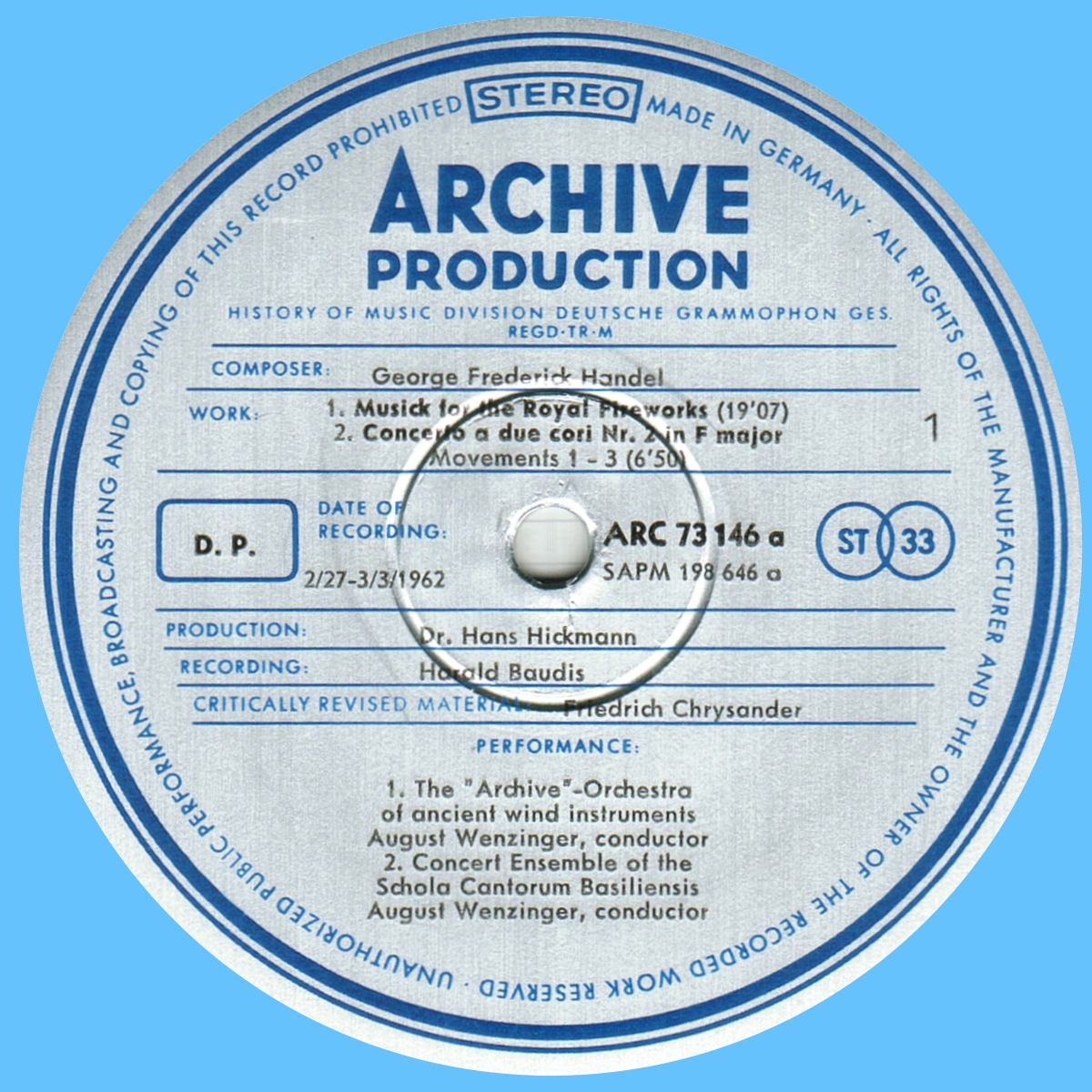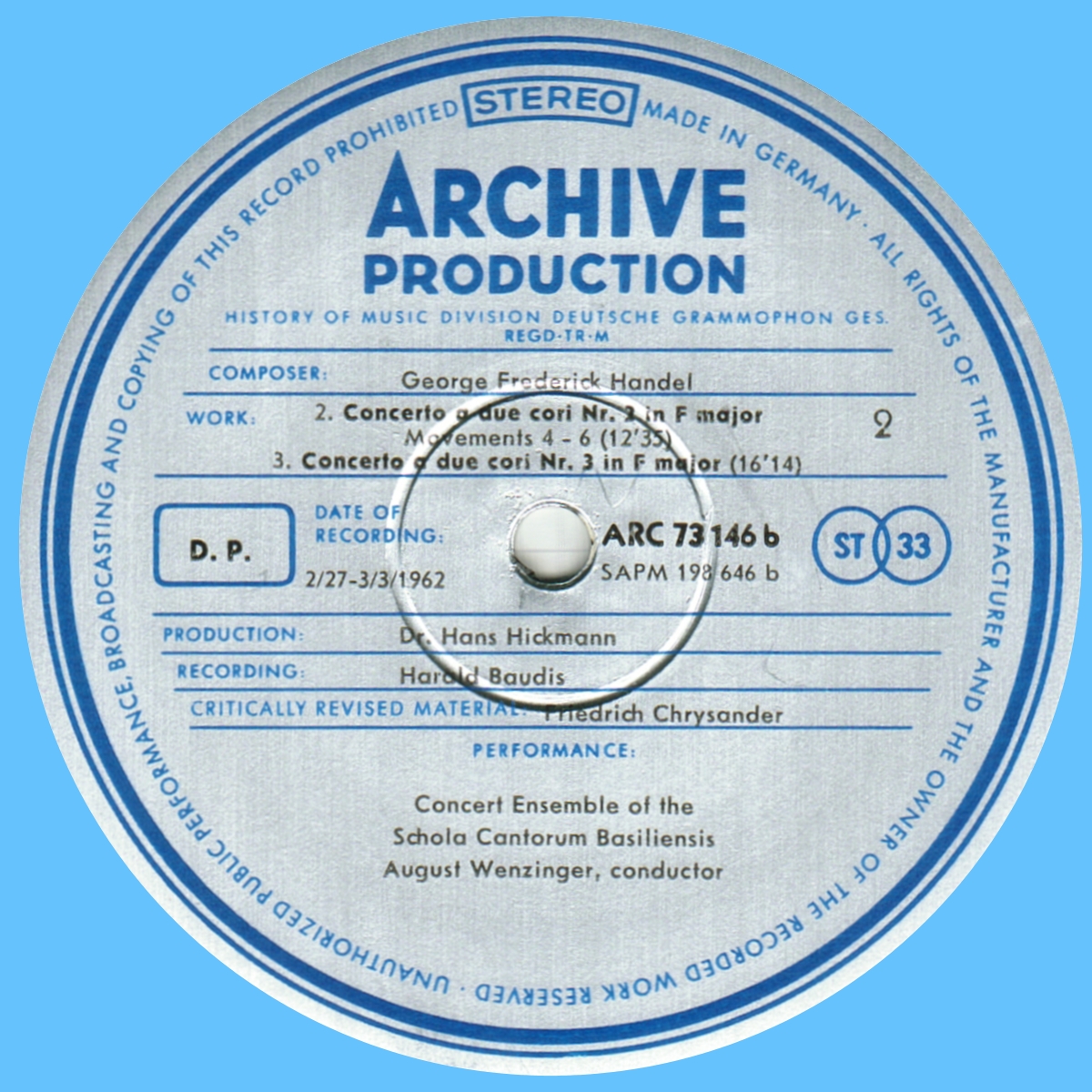Portrait August WENZINGER illustrant l'en-tête de cette rubrique: cité de cette page du site www.bach-cantatas.com, une photo faite par Matthias Hansen
Portrait August WENZINGER à droite: cliquer sur la photo pour vue agrandie et référence
Georg Friedrich HÄNDEL
Concerto a due cori en fa majeur (No 3)
«Orchestral Concert No. 29», HWV 334
Helmut HUCKE, Ingo GORITZKI, hautbois
Gustav NEUDECKER, Edmund STEGNER
Umberto BACCELLI, Peter STEIDLE, cors I/II
Eduard MÜLLER, Valerie KÄGI, clavecins I/II
Ensemble de concert de la Schola Cantorum Basiliensis
August WENZINGER
27 février - 3 mars 1962
Rudolf-Oetker-Halle, Bielefeld
Deutsche Grammophon Archive Production
ARC 73146 198646 SAPM
Les deux Concerti a due cori HWV 333 et 334 ont été composés pour être joués en intermède de certains oratorios, à l'exemple des concertos pour orgue - Due cori, Deux choeurs, signifiant que deux ensembles distincts d'instruments à vent composés chacun d'un basson, deux hautbois et, pour le concerto HWV 333, deux cors, concertent avec l'ensemble des cordes et la basse continue. Leur composition remonte aux années 1747/1748.
Le concerto HWV 333 fut probablement donné en première audition le 23 mars 1748 au Covent Garden Theatre de Londres, lors de la première d'Alexander Balus (HWV 65). Le concerto HW 334 - probablement donné en première audition le 1er avril suivant, également au Covent Garden Theatre, lors de la première de Judas Maccabaeus (HWV 63) - fera ensuite l’objet d’une transcription dans le Concerto pour orgue No 16, HWV 305.
Au verso de la pochette de ce disque enregistré par August Wenziger et l'ensemble de concert de la Schola Cantorum Basiliensis - DG ARC 73146 198646 SAPM - sont donnés les détails suivants:
"[...]The two orchestral concertos (Concerti a due cori) in F major, Nos. 28 and 29, are also occasional compositions by Handel, probably dating from the period between 1746 and 1751. They include Handel's own transcriptions of popular choruses from «The Messiah», the «Birthday Ode for Queen Anne», the two versions of «Esther» and the «Occasional Oratorio». The scoring is for two wind ensembles, each consisting of 2 horns, 2 oboes and 2 bassoons, together with a string orchestra and continuo. These double concertos were occasional works, intended primarily for open-air performances, and they were played before large audiences during popular festivities. In the making of the stereo recording of these works especial prominence was given to the acoustic separation of the two or (including the strings) three instrumental groups, so that the result is a true to life reproduction, corresponding to the original sound of the
music.
A clear picture of the origins of the two concertos, their history and the number and sequence of their movements, has been obtained only recently, although as long ago as 1894 Chrysander referred to the existence of these two concertos in the explanations to the supplementary volume to Vol. 47 of the complete edition of Handel's works. Chrysander was originally of the opinion that the nine movement concerto published in Vol. 47, transcribed from a manuscript in Buckingham Palace, with its fragmentary 10th movement, formed a single work which had survived in an incomplete form. On the other hand he stated in the explanations already mentioned that the double concerto (No. 28) «was not intended to contain all the music published in Vol. 47, pages 159 to 231, but concludes on page 202, as Handel indicated by the word 'Fine'». According to his conclusions, therefore, the 9 (or including the incomplete one 10) movements published in Vol. 47 are not to be regarded as making up a single work, in fact, forming a complete concerto with 6 movements, followed by a further 3 (4) separate pieces. These spare pieces belong, as Chrysander explained, to another double concerto (No. 29), whose remaining movements were discovered in the autograph in the Fitzwilliam Museum, Cambridge. This discovery clarified the question of the succession of movements in the second work, so that the present recording of the two concerti a due cori presents them for the first time in their authentic forms.
This music, broad in conception, making use as it does of echo effects and easily assimilated wind instrument melodies, is of great simplicity and impressiveness. The monumental choral style of the oratorios has here been skilfully transferred to concerto form, so that the new versions are by no means inferior to the originals in tonal richness and splendour. The best-known example is the 3rd movement of Concerto No. 28, a transcription of the chorus «Lift up your heads» from «The Messiah», in which the antiphonal technique of the original version has been adapted with especial felicity to the characteristics of a double orchestra. The other arrangements all diverge to a greater or lesser degree from the original forms, so that they are perfectly suited to the purely instrumental scoring.
«Handel possessed an outstandingly fine feeling for form. No German composer exceeded the beauty of his melodic lines, only Mozart and Hasse equalling him in this respect. Handel's passion for perfection was responsible for the fact that despite his overflowing inventive power he turned again and again to the same ideas those which were best known and which he held in highest favour each time introducing a scarcely noticeable alteration, a pencil mark which made the music even more perfect.»(Romain Rolland). [...]" cité du texte de Günter Schneider publié au verso de la pochette du disque DG Archive Production 198646 SAPM.
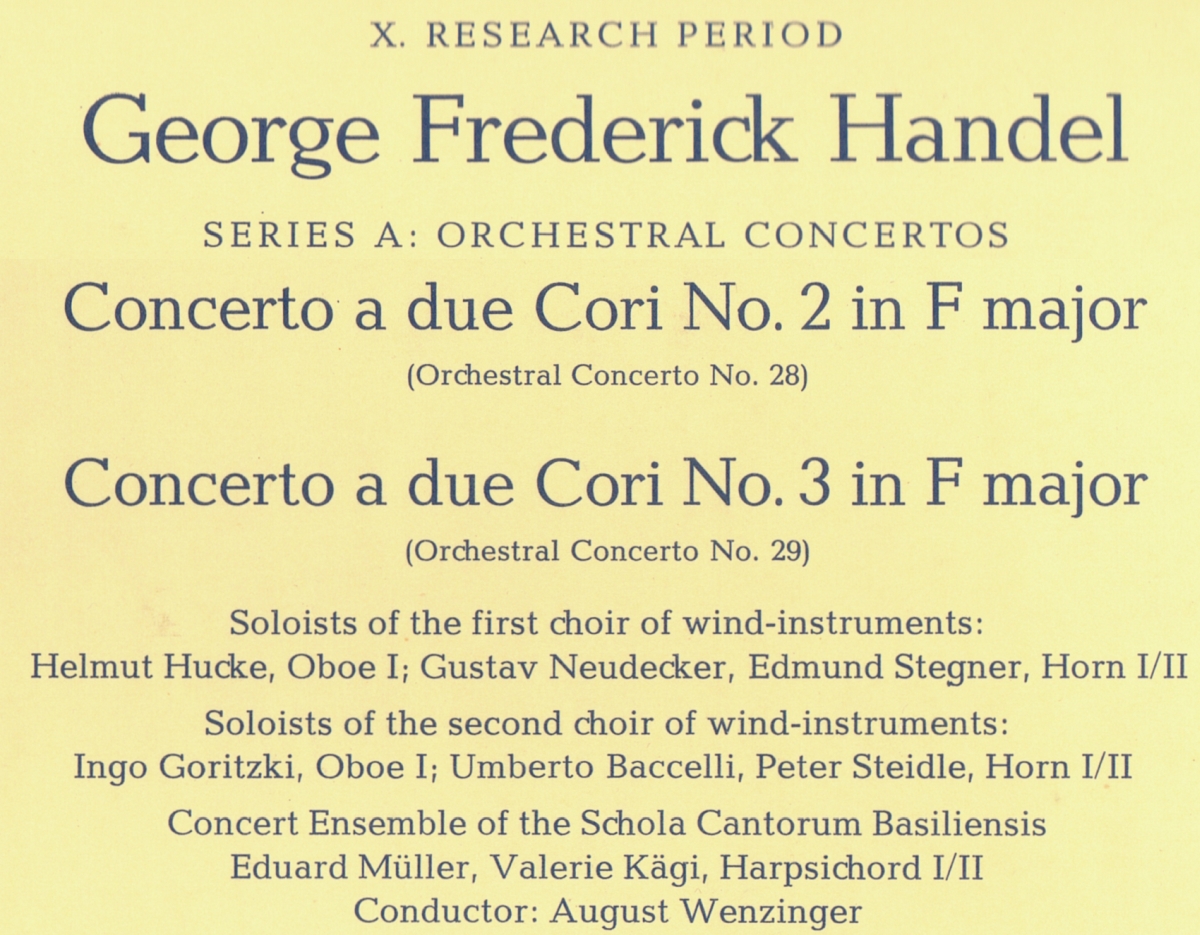
August WENZINGER et les musiciens de la Schola Cantorum Basiliensis furent les premiers à enregistrer ces deux concerti dans leur version définitive, du 27 février au 3 mars 1962 dans la Rudolf-Oetker-Halle de Bielefeld. La première parution eut lieu peu après sur le disque Deutsche Grammophon Archive Production ARC 73146 198646 SAPM (avec la «Musick for the Royal Fireworks» au début de la première face).
Le disque fut présenté dans la revue «The Gramophone» de décembre 1962, en pages 290-291:
"[...](b) Concerti a due cori in F major, Nos. 2 and 3 (Orchestral concertos Nos. 28 and 29) [...] These pieces, only fairly recently sorted out from various scattered manuscripts, are ideally suited to stereo, consisting largely of otherwise familiar music newly laid out for two opposing wind groups (each of two oboes, two horns, and two bassoons) with supporting string orchestra and continuo. They are well performed (with particularly good and in-tune hand-horn playing) and well recorded, with, in the nature of the case, considerable advantage accruing to the stereo version [...]".
Voici donc...
Georg Friedrich Händel, Concerto a due cori en fa majeur (No 3), «Orchestral Concert No. 29», HWV 334, Helmut Hucke, Ingo Goritzki, hautbois (*), Gustav Neudecker, Edmund Stegner, Umberto Baccelli, Peter Steidle, cors I/II (*), Eduard Müller, Valerie Kägi, clavecins I/II, Ensemble de concert de la Schola Cantorum Basiliensis, August Wenzinger, 27 février - 3 mars 1962, Rudolf-Oetker-Halle, Bielefeld, Deutsche Grammophon Archive Production ARC 73146 198646 SAPM
(*) solistes du 1er resp. 2e choeur d'instruments à vents
01. Ouverture 02:03 (-> 02:03)
02. Allegro - Adagio 03:17 (-> 05:20)
03. Allegro ma mon Troppo 03:28 (-> 08:48)
04. Adagio 01:24 (-> 10:12)
05. Andante larghetto 03:55 (-> 14:07)
06. Allegro 02:07 (-> 16:14)
Provenance: disque Deutsche Grammophon Archive Production ARC 73146 198646 SAPM
que vous pouvez obtenir en...
6 fichiers FLAC, 2 fichiers CUE (*) et 1 fichier PDF dans 1 fichier ZIP
(*) 1 fichier CUE pour les fichiers décomprimés en WAV et 1 fichier CUE pour les fichiers comprimés FLAC, si votre logiciel peut utiliser directement les fichiers FLAC.
Recto pochette disque DG Archive Production ARC 73146 198646 SAPM
Étiquette recto disque DG Archive Production ARC 73146 198646 SAPM
Étiquette verso disque DG Archive Production ARC 73146 198646 SAPM




